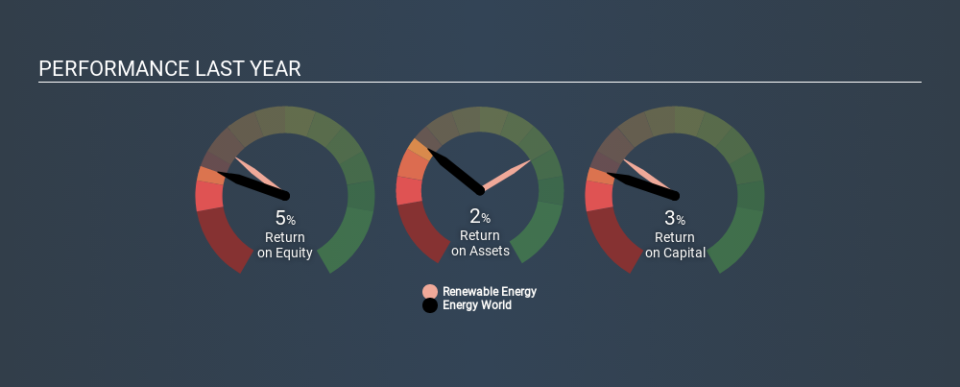Here’s why Energy World Corporation Ltd’s (ASX:EWC) Returns On Capital Matters So Much

Today we are going to look at Energy World Corporation Ltd (ASX:EWC) to see whether it might be an attractive investment prospect. Specifically, we're going to calculate its Return On Capital Employed (ROCE), in the hopes of getting some insight into the business.
Firstly, we'll go over how we calculate ROCE. Next, we'll compare it to others in its industry. Then we'll determine how its current liabilities are affecting its ROCE.
What is Return On Capital Employed (ROCE)?
ROCE is a measure of a company's yearly pre-tax profit (its return), relative to the capital employed in the business. Generally speaking a higher ROCE is better. Ultimately, it is a useful but imperfect metric. Author Edwin Whiting says to be careful when comparing the ROCE of different businesses, since 'No two businesses are exactly alike.
So, How Do We Calculate ROCE?
The formula for calculating the return on capital employed is:
Return on Capital Employed = Earnings Before Interest and Tax (EBIT) ÷ (Total Assets - Current Liabilities)
Or for Energy World:
0.034 = US$49m ÷ (US$1.7b - US$265m) (Based on the trailing twelve months to December 2019.)
So, Energy World has an ROCE of 3.4%.
Check out our latest analysis for Energy World
Is Energy World's ROCE Good?
When making comparisons between similar businesses, investors may find ROCE useful. In this analysis, Energy World's ROCE appears meaningfully below the 9.2% average reported by the Renewable Energy industry. This performance could be negative if sustained, as it suggests the business may underperform its industry. Regardless of how Energy World stacks up against its industry, its ROCE in absolute terms is quite low (especially compared to a bank account). There are potentially more appealing investments elsewhere.
Energy World's current ROCE of 3.4% is lower than 3 years ago, when the company reported a 5.5% ROCE. So investors might consider if it has had issues recently. You can click on the image below to see (in greater detail) how Energy World's past growth compares to other companies.
Remember that this metric is backwards looking - it shows what has happened in the past, and does not accurately predict the future. Companies in cyclical industries can be difficult to understand using ROCE, as returns typically look high during boom times, and low during busts. This is because ROCE only looks at one year, instead of considering returns across a whole cycle. You can check if Energy World has cyclical profits by looking at this free graph of past earnings, revenue and cash flow.
Do Energy World's Current Liabilities Skew Its ROCE?
Short term (or current) liabilities, are things like supplier invoices, overdrafts, or tax bills that need to be paid within 12 months. The ROCE equation subtracts current liabilities from capital employed, so a company with a lot of current liabilities appears to have less capital employed, and a higher ROCE than otherwise. To counteract this, we check if a company has high current liabilities, relative to its total assets.
Energy World has current liabilities of US$265m and total assets of US$1.7b. Therefore its current liabilities are equivalent to approximately 16% of its total assets. This is a modest level of current liabilities, which will have a limited impact on the ROCE.
The Bottom Line On Energy World's ROCE
That's not a bad thing, however Energy World has a weak ROCE and may not be an attractive investment. Of course, you might find a fantastic investment by looking at a few good candidates. So take a peek at this free list of companies with modest (or no) debt, trading on a P/E below 20.
If you like to buy stocks alongside management, then you might just love this free list of companies. (Hint: insiders have been buying them).
If you spot an error that warrants correction, please contact the editor at editorial-team@simplywallst.com. This article by Simply Wall St is general in nature. It does not constitute a recommendation to buy or sell any stock, and does not take account of your objectives, or your financial situation. Simply Wall St has no position in the stocks mentioned.
We aim to bring you long-term focused research analysis driven by fundamental data. Note that our analysis may not factor in the latest price-sensitive company announcements or qualitative material. Thank you for reading.

 Yahoo Finance
Yahoo Finance 
